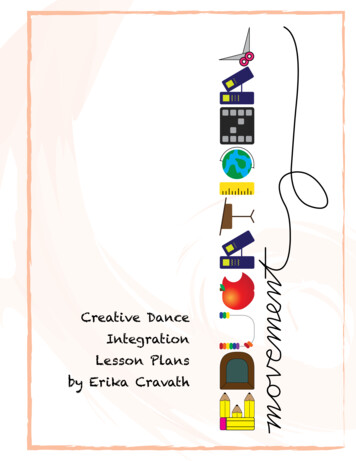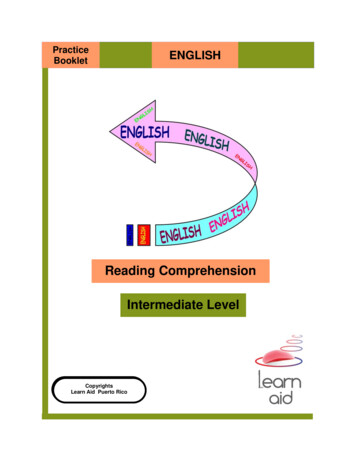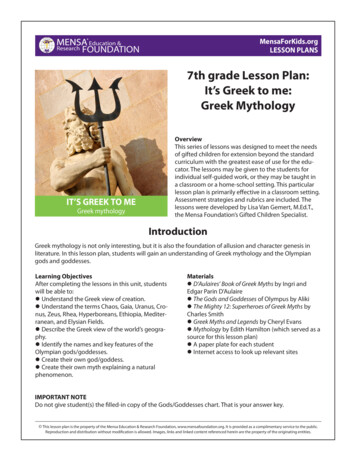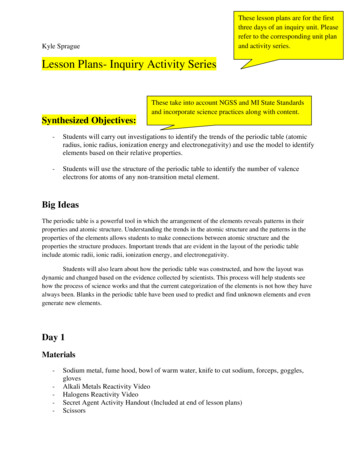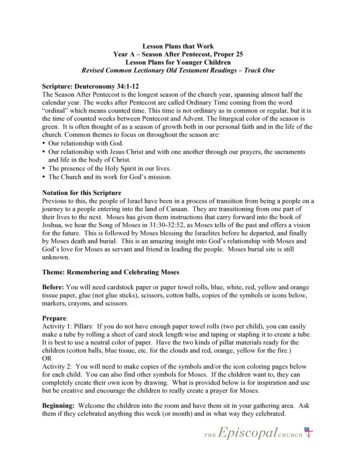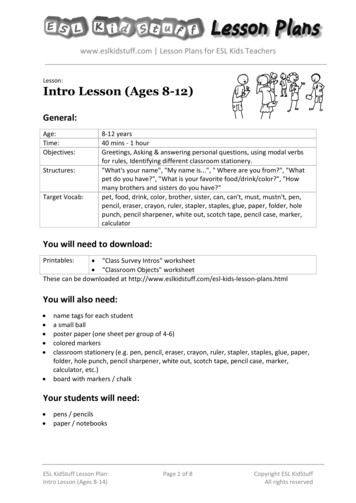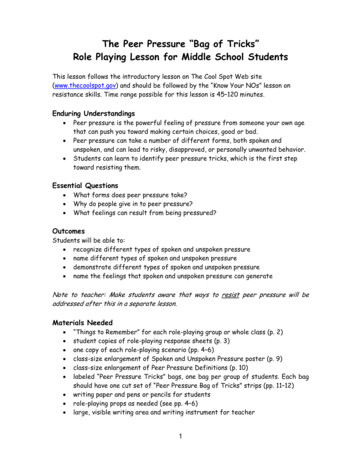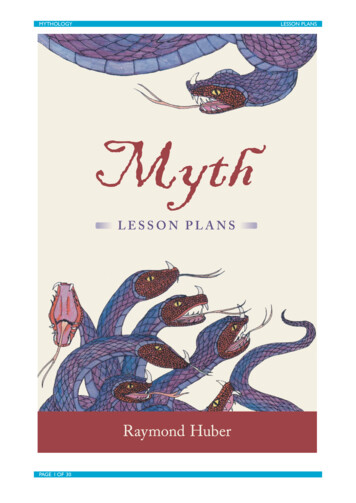
Transcription
MYTHOLOGYPAGE 1 OF 30LESSON PLANS
MYTHOLOGYLESSON PLANS C OPYRIGHT 2013C OPYING : THESE LESSON PLANS CAN ONLY BECOPIED FOR ONE CLASSROOM OF STUDENTSPER PURCHASE .CONTENTSHow To Teach MythsLesson 1: What Do You Know About Myths?Lesson 2: What is a Myth?Lesson 3: Myths of BeginningsLesson 4: Nature Myths – FloodLesson 5: Nature Myths – FireLesson 6: Nature Myths: Honey BeesLesson 7: Hero MythsLesson 8: HeroinesLesson 9: Mythical CreaturesExtra ActivitiesBook ListAbout the AuthorPAGE 2 OF 30
MYTHOLOGYLESSON PLANSHow To Teach MythsWhat is a Myth?Myths are the oldest and most powerful of all story forms. They often carry an important messagefor a culture or group. Myths are stories that give people a relationship with the universe, the passingof time, and with their environment. Some myths give the official view of creation, others are a wayto explain natural events. Myths were passed on by spoken word, and their function was to explain,to teach lessons, and to entertain.Using the Lesson PlansThis book has lesson plans for teaching mythology in the classroom, including creation myths,nature myths, fire myths, and hero myths. It includes activities, write-on tables, flow-charts andillustrations.The following lesson plans are designed for teachers and students. For teachers there are suggestedactivities, definitions and book lists. For students there are worksheets containing charts, questionsand stories.For younger students the main emphasis when teaching is that myths are stories that explain life.The lessons on nature myths are especially suited to young students. Younger children will alsoenjoy myth characters. Reading for pleasure should be another main focus.For older students the cultural identity embedded in myths becomes more important and mythmeanings can be explored in greater depth. The discussion questions at the end of the lesson plansare most suited to older students.The Tale Untangler Flow ChartsThe first question about myths is usually 'How do you tell the difference between myths andlegends? (Or between fairy tales and folktales). Use the Tale Untanglers (the flow-charts below) toclassify the common story types. The Tale Untanglers are simple Yes/No flowcharts showing themain differences between types of traditional storytelling. Teach the students how to use them byreading a myth to the class and using the Tale Untanglers to classify it. Every story is unique andcan't always be neatly defined, so be relaxed about classification.PAGE 3 OF 30
MYTHOLOGYFlow-chart 1. The Theme Untangler asks about the purpose of the story:PAGE 4 OF 30LESSON PLANS
MYTHOLOGYFlow-chart 2: The Character Untangler asks about the characters in the story:PAGE 5 OF 30LESSON PLANS
MYTHOLOGYLESSON PLANSMyth Lesson 1: What Do You Know?AimTo briefly assess students existing knowledge of mythology.WritingAnswer these questions about myths:1.What kind of story do you think a myth is?2.Name some myths that you know:3.What do you think are the differences between a myth, a folktale and a fairytale?4.Does the country you live in have special myths of its own? Name one:Thinking About MythsAgree or disagree?Next to each statement on the following chart, tick whether you agree or disagree:PAGE 6 OF 30
MYTHOLOGYPAGE 7 OF 30LESSON PLANS
MYTHOLOGYLESSON PLANSMyth Lesson 2: What Is A Myth?AimTo classify myths and explore the special features of myths.Definition of a MythThe word myth comes from the Greek word 'mythos' which means 'to tell a story'. Myths are very oldstories which were passed on by the spoken word (before books were invented). Every culture has itsown myths that are centuries old. Myths differ from folktales and legends.Myths are stories with a message. Groups of people (cultures) told myths to explain how life beganand how the world of nature behaved.Special Features of a MythRead a myth. Using the Tale Untangler flowcharts to check if it fits the myth classification.Does the story have any of the following special features of a myth? It explains how life started, or explains natural events. It involves some supernatural power. It involves some supernatural power. The story is not about a real event.Fill in the following chart to describe the special features of each myth you read:PAGE 8 OF 30
MYTHOLOGYStorytellingMyths are best spoken aloud.Read a short myth several times until you remember the main parts.Tell the myth to a small group, using your voice to make it as dramatic as possible.PAGE 9 OF 30LESSON PLANS
MYTHOLOGYLESSON PLANSDiscussion Topics1.What is the difference between myths, legends, and folktales?Legends are not true, but they are based on fact, such as a real person, a place or an event. Thehero myths are the most like legends, but legendary heroes such as Robin Hood usually havehistorical roots, while mythical heroes don't. In legends the focus is also on the adventure plotrather than the message. Folktales tend to be about ordinary people and animals, and folktalesare set in a particular time period. Nature myths can be a bit like folktales, but the purpose offolktales is more for entertainment.2.Are myths true or false?Begin by defining 'fact' and 'truth'. The popular definition of a myth is something that has beenmade-up. However, a myth is often believed to be true by the people who tell it. It may offendpeople to say a myth is false since some myths are the basis of beliefs and religions. Myths cancontain wisdom which is as a kind of truth. A myth may also contain historical elements, especiallythe flood myths. There have been real floods and people have created stories to explain why theyhappened. Read 'The Bunyip of Berkeley Creek' by Jenny Wagner, about the truth in myths.PAGE 10 OF 30
MYTHOLOGYLESSON PLANSMyth Lesson 3: Myths of BeginningsAimTo discuss the explanatory purpose of myths and what they meant to their audience.Creation MythsMyths of beginnings are often called creation myths. This type of myth tries to answer importantquestions about life and the universe. For example: How were people created? Where did theuniverse come from? Different cultures answer these questions in stories. Learning about creationmyths is the study of cosmogony (the 'cosmos' is the universe).ReadingWhere did we come from? There are creation myths from many countries about a giant egg.Here is a myth from China that answers the question about the origin of life:The Cosmic Egg"In the beginning there was a huge egg that held all the opposites — hot and cold, light and dark, wetand dry. Also inside was Phan Ku, a giant who was covered in hair. He had horns on his head andtusks sprang from his mouth.Phan Ku broke out of the egg and separated the opposites through all the world. Every day hecarved out the mountains and oceans with his chisel and mallet. And every day, for 18,000 years hegrew three metres taller.When Phan Ku died his skull became the sky, his breath, the wind, his flesh, soil, and his blood,rivers. The fleas in his hair became human beings."PAGE 11 OF 30
MYTHOLOGYLESSON PLANSTimelineCreate an illustrated time-line about the myth 'The Cosmic Egg'. Your timeline should show theorder of the main events in the story. Begin your timeline at zero. It will have to cover at least18,000 years. Draw Phan Ku above the timeline.ComparingCreation myths help people know they have a special place in the universe. Read five differentcreation myths. Do they have a similar plot or structure? Record information about the structure ofthe myths on the following table:PAGE 12 OF 30
MYTHOLOGYLESSON PLANSWritingAnswer these questions about the origins of life.Note to teacher: Respect all answers and don't grade them or evaluate them.1.Where did the world come from?2.Where did humans come from?3.What creation story do you know that answers these questions?Imagining a Creation MythImagine you are part of a tribe that have a myth to explain where the world came from: What part of the world do you live in? What is the environment like? What is the name of your tribe or group? What kind of gods or God do you have? What is your culture like?Make up a creation myth for your tribe. It should explain how your people or the world came to be.Remember to include the special features of a myth.Group presentationChose one of your creation myths to present a a group.You can use storytelling, art, drama and dance to tell your myth.PAGE 13 OF 30
MYTHOLOGYLESSON PLANSMyths and ScienceMyths and science both give explanations for the world around us.For example, read this creation myth from India:The Tree of Life"In the beginning there was only water. Life came from the water when a mighty tree emerged andgrew up to the sky. But there was a worm inside the tree and it slowly devoured the tree from theinside out. The wood dust fell into the water and gradually formed into the world."How does science explain the beginning of life on Earth?PAGE 14 OF 30
MYTHOLOGYLESSON PLANSMyth Lesson 4: Nature Myths– FloodAimTo recognize the similar patterns in myths from different cultures.The Pattern of Flood MythsThe myth of a disastrous and widespread flood is found in many cultures of the world. For example,the Hebrew story of Noah's Ark, and the Chinese story of a Great Flood.Flood myths usually follow this pattern: Cause: The flood is humankind's punishment. Size: The flood covers the whole land or world. Survivors: A few people survive because they are good. Signs: There's a sign of hope, e.g., a rainbow, to show that life will go on.PAGE 15 OF 30
MYTHOLOGYLESSON PLANSRead three flood myths and see if they fit the pattern above. Fill in this chart for each story:Ark MythsFlood myths often involve a rescue vessel or ark. Read this myth from the Aztec culture:The Aztec Ark"When the people on Earth became wicked, the god of the rain, Tlaloc, became angry and made itrain heavily. But Tlaloc saw that there were two good people, named Tata and Nena. So he warnedTata and Nena that a great flood was on the way. He told them to make an ark by hollowing out ahuge tree trunk. The rain got heavier and Tata and Nena worked quickly to make a hollow log. Justas the flood hit, they climbed inside and were swept away. Eventually the rain stopped and the landappeared again. The Aztec ark had saved Tata and Nena."PAGE 16 OF 30
MYTHOLOGYLESSON PLANSArtCreate a picture of an Ark and decorate it with symbols and designs from a culture.Disaster ReportImagine you are a reporter (TV, internet, radio or newspaper) at the time of the flood. Write a scriptabout what you see happening and interview some survivors. Ask them questions about the flood.Remember the important questions about flood myths: what is the cause, the size, who survived andwhat signs were given?WriteInvent a flood myth for the area you live in, following the pattern of the flood myth.PAGE 17 OF 30
MYTHOLOGYLESSON PLANSMyth Lesson 5: Nature Myths – FireAimTo recognize the similar patterns in myths from different cultures.The Pattern of Fire MythsFire is very useful, but also very dangerous. Fire enabled early humans to cook food and to keepwarm. Almost all cultures have a myth that explains how fire came into the world. For example, theNew Zealand Maori tell how the hero, Maui, got fire for his people by tricking the fire goddess. Firemyths usually follow this pattern: The people have no fire. A hero gets fire from the gods, usually by a clever trick. People find that fire is very useful. But fire also brings evil with it.ReadingRead the following fire myth from Africa. Does it follow the pattern above?The Flying Pygmy"At the beginning of time, God had fire and the pygmy people had none. God's mother sat by the fireall day while God went out and played in the jungle. One of the clever pygmies decided to steal firefrom God. He made himself a pair of wings with a bird's feathers, flew to God's house and picked upfire. But God's mother woke up and cried out,'Thief! Bring back fire or I'll freeze to death.'God rushed home and chased the flying pygmy but couldn't catch him. The pygmy people used fireto keep warm and cook their food. When God returned home he found his mother dead. Since thenthe pygmies have also died."PAGE 18 OF 30
MYTHOLOGYLESSON PLANSSummarize the four main parts of the Flying Pygmy myth:1.2.3.4.Illustrated BookRead some more fire myths. Make a picture book for younger readers retelling a fire myth. Use thepattern of fire myth in your story.The Trickster CharacterThe trickster is a common character in myths, especially in fire myths. Read some trickster storiessuch as the Prometheus myth from Greece, the Anansi stories from Africa, and the Coyote storiesfrom North America. Is a trickster a hero?Write your own trickster tale about a naughty animal.PAGE 19 OF 30
MYTHOLOGYLESSON PLANSMyth Lesson 6: Nature Myths – Honey BeesAimTo compare cultural messages.Bee MythologyAbout 20,000 years ago people started hunting for honey, then 3,000 years ago they made hives forbees to live in. The following ancient myths about honey bees are from different cultures. Each oneexplains something different about honey bees and beekeeping.Read the following bee myths and after each one write what real life facts it explains and whatmessage it conveys.1.Brazil"In the beginning, honey was found in huge pots on the ground, and people ate as much as theyliked. The gods looked down and were greatly displeased. “Those humans are becoming fat andlazy,” they said. The gods commanded the bees to build honey comb high in the tall jungle trees.Now people had to work hard to climb up and get the honey."Fact: Honey bees make their nests high up in hollow trees, and high on cliff faces.2.Thailand"Long, long ago, elephants did not have trunks. One day a terrible forest fire swept over the land. Toescape the smoke, the honey bees hid inside the elephants’ mouths. The elephants trumpetedangrily, but the bees would not come out. The elephants blew so hard, their mouths stretched outinto trunks. In desperation, the elephants breathed in the stinging smoke and the bees finally buzzedoff. Since then, bees have always built honeycomb in hollow trees, because it reminds them ofelephant trunks."Fact: Smoke is used to control bees; and elephants are scared of bees.PAGE 20 OF 30
MYTHOLOGY3.LESSON PLANSAustralia"Two Numerji brothers went on walkabout. They came across some bees collecting the sweet nectarfrom flowers. The brothers wondered how they could follow the bees back to their nest. The olderbrother had a bright idea. He attached a thread of sticky spider web to a bee. This made the bee easyto follow, and the younger brother ran after it. He tracked the bee to a hollow tree. There he found adelicious honeycomb – or sugarbag as Aboriginal Australians still call it today."Fact: Honey hunters in Australia glued a small feather to a bee and followed it to the hive.4. Africa"Bee was a kindly creature. One night, Mantis needed to cross a great, flooded river to reach hisfamily, and asked Bee for help. Bee offered to carry Mantis on her back. She flew over the ragingwaters but was beaten down by a strong wind. Bee was dangerously close to the waves when shesaw a magnificent flower floating on the water. Bee dropped Mantis onto the flower, fell beside her,and died of exhaustion. When the sun rose, curled up on the flower was the first human being –bee’s sacrifice."Fact: Honey bees live for about 40 days and then they die of exhaustion after so much flying.PAGE 21 OF 30
MYTHOLOGYLESSON PLANSMyth Lesson 7: Hero MythsAimTo recognize patterns in hero myths and link them with comic and movie heroes.The Pattern of Hero MythsMost myths have a hero who is brave, clever or strong. Some examples are Perseus, Maui, Sigurd,Jason and Beowulf. The hero brings important gifts to his people (e.g. fire). He is a role model ofright behavior and is greatly admired.The life story of a mythical hero usually follows this pattern: He has a special birth. He has unusual skills as a child. He is tested as a young man. He goes on a journey or quest to find something. He has difficult tasks to do. He has one weakness. He is rewarded for his effort. He dies a special death.Read a hero myth and see if you can find examples of each main event listed above.WritingInvent your own mythical hero.Write a biography of your hero. Include all the main events in his life and draw a portrait of thehero.Answer the following questions before writing about your hero:PAGE 22 OF 30
MYTHOLOGYLESSON PLANSIllustrateCreate a comic strip or book about your hero. Use the style of Superman or The Avengers comics.PAGE 23 OF 30
MYTHOLOGYLESSON PLANSMyth Lesson 8: HeroinesAimTo imagine a modern myth with female characters.ReadingMost of the heroines of myth come from Greece. Some are goddesses, such as Athena and Demeter;and others are human, such as Atalanta, Helen and Ariadne. Read some of their stories.Atalanta and the Wild Boar"When Atalanta was born, her father was disappointed the child was not a boy. Atalanta was taken intothe mountains to die, but a she-bear looked after her.Growing up in the wilds she became an expert hunter and a fast runner. There was a competition tokill a huge wild boar and Atalanta joined in the hunt. The boar ambushed the hunters, killing many ofthem, but Atalanta wounded it with an arrow. She won the skin of the boar for being the first to hit it.She refused to marry anyone unless he could outrun her in a 100 meter race. Many young men trieduntil a Prince named Melanion beat her by throwing golden apples in front of her."CompareMyths with female characters don't usually follow a pattern. Compare the story of Atalanta with thepattern of a hero myth. What are the differences?Find another myth where the heroine defeats a monster.PAGE 24 OF 30
MYTHOLOGYLESSON PLANSImagining a Modern HeroineWhat would happen if a mythical heroine appeared in your town today?1.What is her name?2.What kind of person is she?3.What does she do that might upset some people?4.What do the news headlines say about her?5.What TV shows and movies are made about her?DiscussWhy are there fewer stories about mythical heroines than about heroes?It is harder to find stories about women than men in mythology. Most ancient societies werepatriarchal (male-dominated) and the men were story-tellers and leaders. However, in legends thereare many more women (because they are more historical) and also in folktales. In mythology, thefemale characters are often goddesses.PAGE 25 OF 30
MYTHOLOGYLESSON PLANSMyth Lesson 9: Mythical CreaturesAimTo advertise a mythical monster.ResearchHeroes have to fight against evil, usually in the form of powerful monsters or supernatural creatures.For example, the hero Gilgamesh had to kill the monster Humbaba in his quest for life everlasting.Find out about the following creatures and write a brief description of each one on the chart:PAGE 26 OF 30
MYTHOLOGYLESSON PLANSFind out which myths the monsters above come from and raw your own chart showing theinformation.AdvertisingRead some myths that have creatures or monsters in them.Imagine you are advertising a movie about a mythical creature. Design and publish a movie posterusing one of the creatures from myths you have read.PAGE 27 OF 30
MYTHOLOGYLESSON PLANSExtension ActivitiesExtension ActivitiesThe following activities are designed to extend students:1.Students find myths from different countries that explain the origins of death. How common isthe idea of a soul or an afterlife in mythology?2.Find out the mythological origins of these English words and sayings:* Achilles Heel* Labyrinth* Titanic*Panic*Tantalize* The Midas Touch3.Find a nature myth that explains the formation of some geographical feature (for example, anisland) and then find out the scientific explanation.4.Create a Who's Who website of mythical characters and creatures.5.Look for patterns in creation myths. For example, creation myths often begin with the world inchaos, covered in water, or inside an egg. Divide the myths into categories.6.Debate this statement: 'Part of a myth is true.'7.Read news reports to identify real life heroes and heroines. Why do these people inspire us?8.Study the culture or religion behind a favorite myth.9.Research the legends of Joan of Arc or Robin Hood. In what ways are their stories like myths?What are the historical elements of these stories?10. Greeks and Romans had Gods with similar kingdoms but different names.PAGE 28 OF 30
MYTHOLOGYFind the Roman counterparts of the following Greek Gods: Zeus Poseidon Hades Hephaestus Hermes Hera Aphrodite Artemis DemeterMyth Book ListAnthologiesThe Kingfisher Book of Mythology.Farmer, P. Beginnings.Johnson, M. The Greeks and Their Myths.Alpers, A. Maori Myths and Tribal Legends.Leeming, D. A Dictionary of Creation Myths.Bishop, G. Weaving Earth and Sky.Creation MythsStewart, M and Base, G. Creation Stories.Baynes, P. In the Beginning.Johnson, J. The Creation.Mayo, M. The Orchard Book of Creation Stories.PAGE 29 OF 30LESSON PLANS
MYTHOLOGYLESSON PLANSFlood and Fire MythsHarrison, M. Noah's Ark.Ganeri, A. Out of the Ark.Krishnaswami, U. Stories of the Flood.London, J. Fire Race.Robinson, J. Coyote the Trickster.Gosage, P. How Maui found the Secret of Fire.Hero and Heroine MythsIngpen, R. Heroes and Heroines.Geringer, L. Myth MenSlane, C. Maui, Legend of the Outcast.Saxby, M. The Great Deeds of Heroic Women.Monster MythsMayo, M. Orchard Book of Mythical Birds and Beasts.Ragache, C. Fabulous BeastsGaneri, A. Dragons and Monsters.About the AuthorRaymond Huber is a children's author, education writer and teacher. His books include the novelsSting and Wings (Walker Books); a picture book, Flight of the Honey Bee (Candlewick Press);English and Science books (ESA Publications); and the ebook, Honey Bees, An Essential Guide.Cover Design by Caroline JacksonPAGE 30 OF 30
stories which were passed on by the spoken word (before books were invented). Every culture has its own myths that are centuries old. Myths differ from folktales and legends. Myths are stories with a message. Groups of people (cultures) told myths to explain how life began and how the world o

